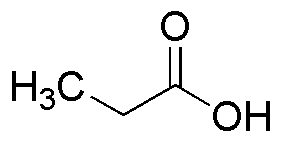Propionic acid is widely utilized in research focused on:
- Food Preservation: This compound acts as a natural preservative in baked goods and dairy products, inhibiting the growth of mold and bacteria, thus extending shelf life.
- Agricultural Applications: Used as a herbicide and fungicide, propionic acid helps in controlling unwanted plant growth and protecting crops from fungal infections, enhancing agricultural productivity.
- Pharmaceutical Manufacturing: It serves as an intermediate in the synthesis of various pharmaceuticals, including anti-inflammatory and antifungal medications, ensuring effective drug formulation.
- Animal Feed Additive: By promoting gut health and preventing spoilage, propionic acid is added to animal feed, improving livestock growth rates and overall health.
- Industrial Chemical Production: This compound is utilized in the production of various chemicals, including plastics and solvents, making it essential in manufacturing processes across multiple industries.
General Information
Properties
Safety and Regulations
Applications
Propionic acid is widely utilized in research focused on:
- Food Preservation: This compound acts as a natural preservative in baked goods and dairy products, inhibiting the growth of mold and bacteria, thus extending shelf life.
- Agricultural Applications: Used as a herbicide and fungicide, propionic acid helps in controlling unwanted plant growth and protecting crops from fungal infections, enhancing agricultural productivity.
- Pharmaceutical Manufacturing: It serves as an intermediate in the synthesis of various pharmaceuticals, including anti-inflammatory and antifungal medications, ensuring effective drug formulation.
- Animal Feed Additive: By promoting gut health and preventing spoilage, propionic acid is added to animal feed, improving livestock growth rates and overall health.
- Industrial Chemical Production: This compound is utilized in the production of various chemicals, including plastics and solvents, making it essential in manufacturing processes across multiple industries.
Documents
Safety Data Sheets (SDS)
The SDS provides comprehensive safety information on handling, storage, and disposal of the product.
Product Specification (PS)
The PS provides a comprehensive breakdown of the product’s properties, including chemical composition, physical state, purity, and storage requirements. It also details acceptable quality ranges and the product's intended applications.
Certificates of Analysis (COA)
Search for Certificates of Analysis (COA) by entering the products Lot Number. Lot and Batch Numbers can be found on a product’s label following the words ‘Lot’ or ‘Batch’.
*Catalog Number
*Lot Number
Certificates Of Origin (COO)
This COO confirms the country where the product was manufactured, and also details the materials and components used in it and whether it is derived from natural, synthetic, or other specific sources. This certificate may be required for customs, trade, and regulatory compliance.
*Catalog Number
*Lot Number
Safety Data Sheets (SDS)
The SDS provides comprehensive safety information on handling, storage, and disposal of the product.
DownloadProduct Specification (PS)
The PS provides a comprehensive breakdown of the product’s properties, including chemical composition, physical state, purity, and storage requirements. It also details acceptable quality ranges and the product's intended applications.
DownloadCertificates of Analysis (COA)
Search for Certificates of Analysis (COA) by entering the products Lot Number. Lot and Batch Numbers can be found on a product’s label following the words ‘Lot’ or ‘Batch’.
*Catalog Number
*Lot Number
Certificates Of Origin (COO)
This COO confirms the country where the product was manufactured, and also details the materials and components used in it and whether it is derived from natural, synthetic, or other specific sources. This certificate may be required for customs, trade, and regulatory compliance.


